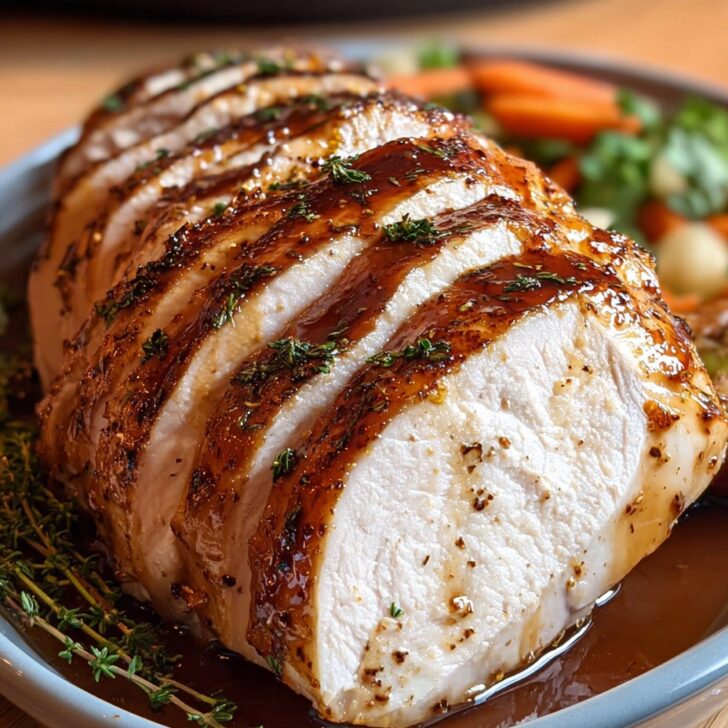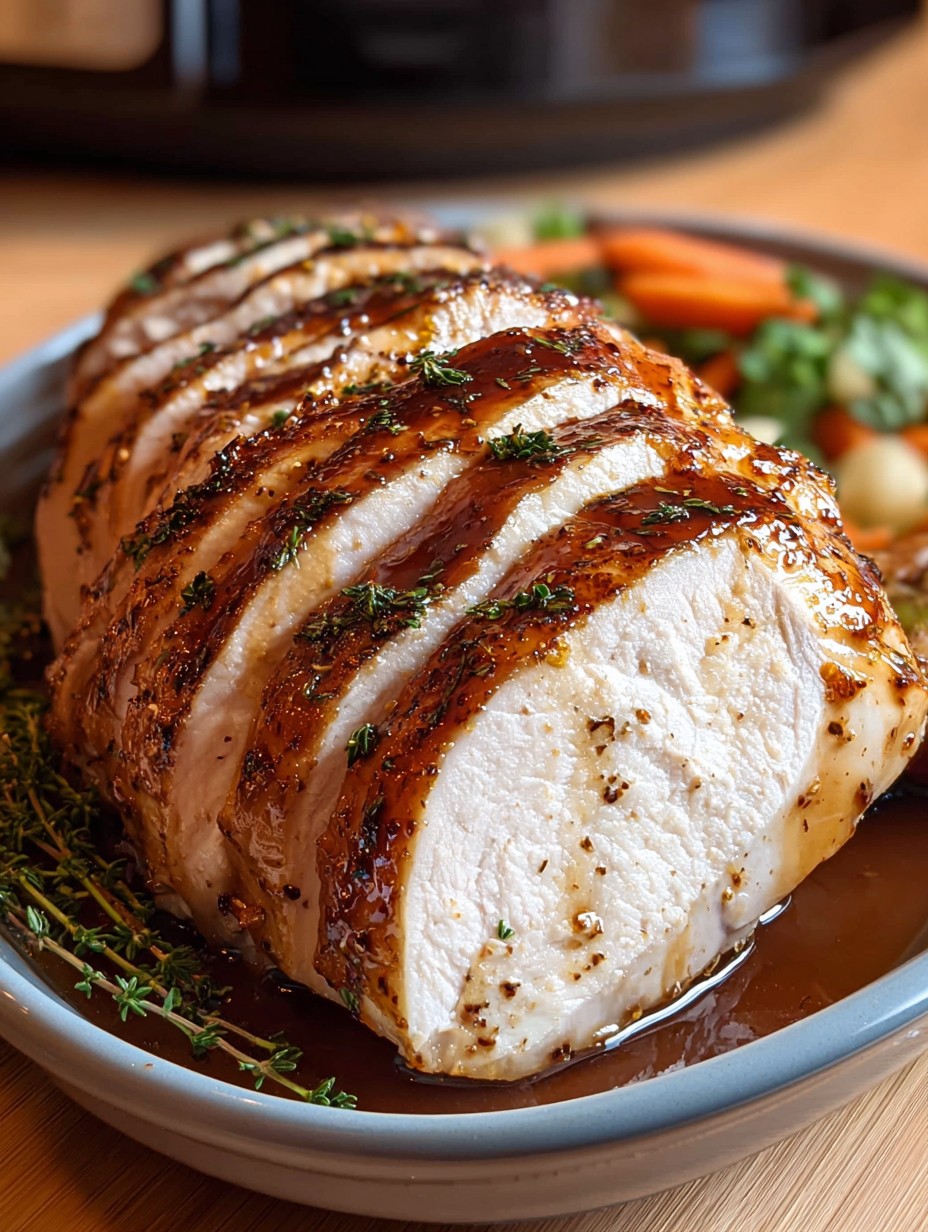So, Let Me Tell You About My Amish Maple Turkey Breast Adventure…
Hey there! Okay, story time: the first time I made this Slow Cooker Amish Maple Turkey Breast, I was up to my elbows in peeling potatoes with my wild dog chasing her own tail in the background. You know the kind of day—when you just need something comforting but don’t want to hover over the stove for hours. (Spoiler: I also wanted my kitchen to smell like maple-sweet heaven without setting off the smoke alarm — which, yes, I have managed before. We don't talk about Thanksgiving ‘19...)
Why You'll Love This (Or at Least Why I Do...)
I make this when I feel like impressing people without, well, doing all that much work. My family goes a little bonkers for this—there's maple syrup, turkey, and it just falls apart. The slow cooker does all the heavy lifting. (Well, except for the actual lifting—someone always tries to sneak a piece out before dinner. Looking at you, Uncle Pete!) Oh, and honestly, the leftovers (if you manage to have any) are maybe even better. I don’t know, I tend to think most things taste better on day 2, but maybe that’s just because I can eat them in peace the next day.
Your Grocery List (And a Few Cheeky Swaps)
- 1 boneless turkey breast (mine was 2-ish lbs, give or take; I’ve used bone-in once and it still worked, albeit slightly messier to slice)
- ⅓ cup pure maple syrup (not the fake stuff, though if that’s all you’ve got, you’ll still be ok; my grandma swore by the good Canadian kind)
- 2 tablespoon Dijon mustard (I've tried whole grain and it’s fine if you like a bit more texture)
- 2 tablespoon apple cider vinegar (or, honestly, just a splash of white vinegar in a pinch)
- 2 garlic cloves, minced (powder works, but fresh is, you know, better)
- 1 teaspoon smoked paprika (I sometimes use regular sweet paprika 'cause it’s what’s in the cupboard)
- 1 teaspoon kosher salt
- ½ teaspoon black pepper (freshly cracked is nice, but I'm not the pepper police)
- 2 tablespoon melted butter (olive oil is ok if you’re feeling virtuous)
- 1 small onion, sliced (if you hate onions, skip it; but it does add something special)
Let’s Get Cooking (It’s Easier Than Misplacing Your Crockpot Lid... Trust Me)
1. First things first, pat your turkey dry (paper towels, not your shirt—voice of experience). Sprinkle it with salt, pepper, and paprika, rub it in—like a relaxing spa day, just for meat.
2. Toss those sliced onions in the bottom of your slow cooker. They make a nice bed, and catch all the juices—no more turkey stuck to the pot (I learned this after, uh, not doing it the first time).
3. In a bowl, whisk the maple syrup, Dijon, vinegar, garlic, and melted butter. Pour about half of it over the turkey. Then, pop the lid on—don’t panic if it’s a little messy. I usually spoon the rest of the glaze over halfway through, but honestly, sometimes I forget and just dump it all at the start. Nobody complained.
4. Cook on LOW for 4 to 5 hours. Some slow cookers run hot, some are more sloth-like—so check around 4 hours if you’re a bit paranoid like me. The turkey should hit 165°F (or "about as juicy as a holiday roast" if you like guesswork). And if it looks a little pale? That’s normal. It’s not meant to look like it’s spent a week in the sun.
5. Take the turkey out, tent it with foil, and rest for at least 10 minutes (yes, I know, patience—it matters!). Slice and drizzle with those tangy-sweet juices. If you want to thicken the juices, a little cornstarch slurry in a saucepan does the trick, but I usually can’t be bothered (it still tastes great).
Notes You Won’t Find on Most Cooking Blogs (A.K.A. My Goofs)
- The onions get super soft, almost melt away—you could probably mash them into the sauce, too. I sort of like that.
- Once, I overcooked it by leaving it on 'keep warm' for way too long; the turkey didn’t die but it was kinda stringy.
- I forgot the vinegar once and, well, it was missing the zing, so don’t skip that even if you think no one will notice.
What Else Can You Try? (Or Regret...)
- Tried this once with chicken breasts—worked, but the turkey flavor is, honestly, the best part.
- One time I tossed in some chopped apples—sorta interesting, but didn’t really wow anyone. Maybe pears next time?
- You could try honey instead of maple in a pinch, but it’s not quite the same. Kind of like salted caramel vs. butterscotch—similar but still, you know, not.
Kitchen Tools: Here’s What I Use (But You Don’t Need to Be Fancy)
- Slow cooker (if you don’t have one, a heavy Dutch oven on super-low in the oven works—just check on it occasionally)
- Mixing bowl (or a big-enough coffee mug; I won't judge)
- Meat thermometer (good to have, but honestly, I usually poke it and see if it feels right)

Storage Know-How (Though Ours Vanishes Fast)
Tuck leftovers in a sealed container, right in the fridge—should keep 3, even 4 days. But, honestly, I’ve never had it stick around past day two. Sometimes I even sneak bites cold form the fridge, but shhh, that's a secret.
How We Serve This (And Why My Forks Disappear)
I love serving big, juicy slices with mashed potatoes and green beans (classic, but you do you). A scoop of the onions and sauce drizzled over really ties everything together. On particularly chilly days, I’ll slap leftovers on crusty bread for sandwiches—so good. My cousin once topped it on salad and called it "hipster Thanksgiving"—works for me.
Learned the Hard Way: My Pro Tips
- Letting it rest before slicing? Don’t skip! I once cut right in—juices went everywhere. Sad turkey.
- Resist the temptation to crank your slow cooker up to HIGH—yeah, I was impatient; yeah, the turkey was a little tough. Low and slow really is best.
- I've found lining the slow cooker with parchment saves a lot of scrubbing, but don’t use wax paper by mistake (voice of panicked experience)
The Usual Questions (Yes, I've Been Asked These!)
- Q: Can I make it ahead?
A: Definitely. I even think it tastes better the next day (leftovers on a sandwich? Yes, please!) - Q: What size slow cooker should I use?
A: I use a 5 quart—that's a happy medium. If yours is smaller, just wedge the turkey in a bit. If it's massive, maybe use some extra onions. - Q: Is this actually Amish?
A: Sort of? The maple-Dijon thing comes from old Amish cookbooks (check out Amish365.com for some fun reading), but honestly, it’s my own riff. - Q: Can I use frozen turkey breast?
A: I’ve done it, but thawing overnight is safer. Things cook unevenly from frozen—just saying! - Q: What if I don’t have maple syrup?
A: Well...you can use honey or brown sugar in a pinch, but maple is what makes it shine. (You might want to check Smitten Kitchen’s take on maple glazes for extra inspiration—I do now and then!) - Q: Got a vegetarian version?
A: Haven’t cracked that yet. Maybe try big portobello caps with the same marinade? If you make it work, let me know!
Oh, and if you love simple comfort-food meals, try checking out my go-to mashed potatoes from Budget Bytes (not sponsored, just a fan). Anyway, if you cook this maple turkey breast, let me know how it went. Or invite me over. I’ll bring pie—or at least my own fork.
Ingredients
- 1 (3 to 4 lb) boneless turkey breast, skin on
- ⅓ cup pure maple syrup
- 2 tablespoons Dijon mustard
- 2 tablespoons apple cider vinegar
- 1 tablespoon soy sauce
- ½ teaspoon dried thyme
- ½ teaspoon garlic powder
- 1 teaspoon salt
- ½ teaspoon black pepper
Instructions
-
1Pat turkey breast dry and season on all sides with salt, black pepper, dried thyme, and garlic powder.
-
2In a small bowl, whisk together maple syrup, Dijon mustard, apple cider vinegar, and soy sauce.
-
3Place the turkey breast in the slow cooker. Pour the maple mixture over the turkey, ensuring it is evenly coated.
-
4Cover and cook on low for 6 hours, or until the turkey breast is tender and the internal temperature reaches 165°F (74°C).
-
5Remove turkey from the slow cooker and let rest for 10 minutes before slicing. Serve with spooned-over cooking juices.
Approximate Information for One Serving
Nutrition Disclaimers
Number of total servings shown is approximate. Actual number of servings will depend on your preferred portion sizes.
Nutritional values shown are general guidelines and reflect information for 1 serving using the ingredients listed, not including any optional ingredients. Actual macros may vary slightly depending on specific brands and types of ingredients used.
To determine the weight of one serving, prepare the recipe as instructed. Weigh the finished recipe, then divide the weight of the finished recipe (not including the weight of the container the food is in) by the desired number of servings. Result will be the weight of one serving.
Did you make this recipe?
Please consider Pinning it!!


